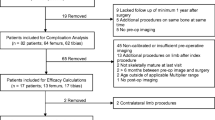Abstract
Purpose
The purpose of this study was to assess percutaneous femoral distal hemi-epiphysiodesis using transphyseal cannulated screws in order to correct valgus angular deformities of the knee in pediatric and adolescent patients.
Methods
This is a prospective longitudinal study in which our experience with 52 patients is described.
Results
We evaluated 100 knees surgically managed for pathologic genu valgum over a 68-month period. The average age at surgery for boys and girls was 14 years and 7 months (range 12.7–15.1 years) and 13 years and 6 months (range 12.9–14.8 years), respectively. The pre-surgical tibiofemoral (T–F) angle was measured at between 14.17° and 35.3°, and the postoperative T–F was measured at between 6.2° and 15.8° (7.2° ± 0.65°, mean ± standard deviation), for an average correction of 0.73° ± 0.45° per month). The mean follow-up after surgery was 3.2 years (range 2.3–5.3 years).
Conclusions
We demonstrate a simple, fast and reproducible surgical technique for percutaneous epiphysiodesis with low morbidity, rapid rehabilitation and a rapid return to school and sports activities. We experienced no complications, such as overcorrection, undercorrection, postoperative hematoma or infection. We conclude that percutaneous screw epiphysiodesis is an excellent option for the treatment of genu valgum in adolescents.




Similar content being viewed by others
References
Blair VP, Walker SJ, Sheridan JJ et al (1982) Epiphysiodesis: a problem of timing. J Pediatr Orthop 2:281–284
Sánchez M, Pedro A (2004) Manual Práctico para Residentes de Ortopedia. Editorial Carbel, Bogotá
Bylski-Austrow DI, Wall EJ, Rupert MP et al (2001) Growth plate forces in the adolescent human knee: a radiographic and mechanical study of epiphyseal staples. J Pediatr Orthop 21(6):817–823
Phemister DB (1933) Operative arrestment of longitudinal growth of bones in the treatment of deformities. J Bone Joint Surg Am 15:1–15
Hass SL (1945) Retardation of bone growth by a wire loop. J Bone Joint Surg (Am) 27:25–36
Blount WP (1949) Control of bone growth by epiphyseal stapling: a preliminary report. J Bone Joint Surg Am 31:464–478
Zuege RC, Kempken TG, Blount WP (1979) Epiphyseal stapling for angular deformity at the knee. J Bone Joint Surg Am 61:320–329
Stevens PM, Maguire M, Dales MD, Robins AJ (1999) Physeal stapling for idiopathic genu valgum. J Pediatr Orthop 19(5):645–649
Bowen JR, Johnson WJ (1984) Percutaneous epiphysiodesis. Clin Orthop 190:170–173
Bowen JR, Torres RR, Forlin E (1992) Partial epiphysiodesis to address genu varum or genu valgum. J Pediatr Orthop 12:359–364
Timperlake RW, Bowen JR, Guille JT et al (1991) A prospective evaluation of fifty-three consecutive percutaneous epiphysiodesis of the distal femur and proximal tibia and fibula. J Pediatr Orthop 11:350–357
Horton GA, Olney B (1996) Epiphysiodesis of the lower extremity: results of the percutaneous technique. J Pediatr Orthop 16:180–182
Canale ST, Russell TA, Holcomb RL (1986) Percutaneous epiphysiodesis: experimental study and preliminary clinical results. J Pediatr Orthop 6:150–156
Nouth F, Kuo LA (2004) Percutaneous epiphysiodesis using transphyseal screws (PETS): prospective case study and review. J Pediatr Orthop 24:721–725
Gabriel KR, Crawford AH, Roy DR et al (1994) Percutaneous epiphysiodesis. J Pediatr Orthop 14(3):358–362
De Brauwer V, Moens PMD (2008) Temporary hemiepiphysiodesis for idiopathic genua valga in adolescents: percutaneous transphyseal screws (PETS) versus stapling. J Pediatr Orthop 28(5):549–554
Burghardt RD, Herzenberg JE, Shawn C et al (2008) Temporary hemiepiphyseal arrest using a screw and plate device to treat knee and ankle deformities in children: a preliminary report. J Child Orthop 2(3):187–197
Metaizeau JP, Wong-Chung J, Bertrand H et al (1998) Percutaneous epiphysiodesis using transphyseal screws (PETS). J Pediatr Orthop 18:363–369
Khoury J, Tavares J, Mcconnell S et al (2007) Results of screw epiphysiodesis for the treatment of limb length discrepancy and angular deformity. J Pediatr Orthop 27(6):623–628
Gómez A, Turriago CA, Jiménez ML (1996) Epifisiodesis química con quimopapaína Intrafisiaria: modelo experimental en conejos. Rev Colomb Ortop Traumatol 10(3):217–222
Lee C, Bier AD, Nickisch F et al (2007) Epiphysiodesis with infusion of stromal. J Bone Joint Surg Am 89:102–113
Paley D, Tetsworth KT (1992) Mechanical axis deviation of the lower limbs: preoperative planning of uniapical angular deformities of the tibia and femur. Clin Orthop 280:48–64
Salenius P, Vankka E (1975) The development of the tibiofemoral angle in children. J Bone Joint Surg Am 57:259–261
Guarniero R, Luzo CAM, Arena EC et al (1994) Correção de deformidade angular dos membros inferiores pela técnica de agrafagem. Genuvalgo. Rev Bras Ortop 29:19–23
Fraser RK, Dickens DRV, Cole WG (1995) Medial physeal stapling for primary and secondary genu valgum in late childhood and adolescence. J Bone Joint Surg Br 77:733–735
Healy WL, Anglen JO, Wasilewski SA, Krackow KA (1988) Distal femoral varus steotomy. J Bone Joint Surg Am 70(1):102–109
Canale ST, Christian CA (1990) Techniques for epiphysiodesis about the knee. Clin Orthop 255:81–85
Liotta FJ, Ambrose TA 2nd, Eilert RE (1992) Fluoroscopic technique versus Phemister technique for epiphysiodesis. J Pediatr Orthop 12(2):248–251
Kramer A, Stevens PM (2001) Anterior femoral stapling. J Pediatr Orthop 21(6):804–807
Sharma L, Song J, Felson DT (2001) The role of knee alignment in disease progression and functional decline in knee osteoarthritis. JAMA 286:188–195
Author information
Authors and Affiliations
Corresponding author
About this article
Cite this article
Mesa, P.A.S., Yamhure, F.H. Percutaneous hemi-epiphysiodesis using transphyseal cannulated screws for genu valgum in adolescents. J Child Orthop 3, 397–403 (2009). https://doi.org/10.1007/s11832-009-0203-8
Received:
Accepted:
Published:
Issue Date:
DOI: https://doi.org/10.1007/s11832-009-0203-8




